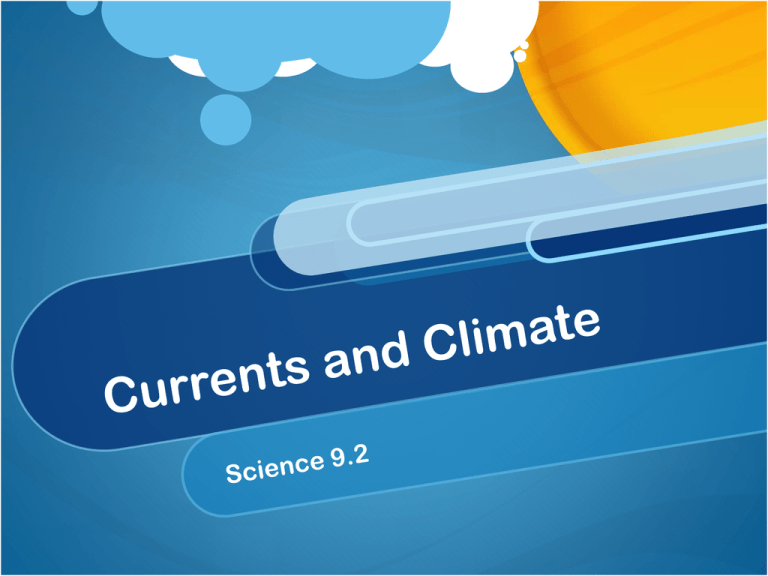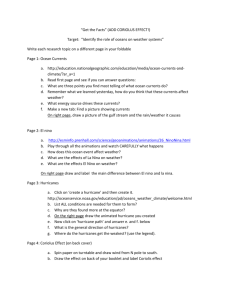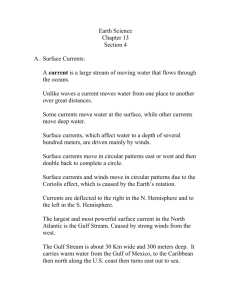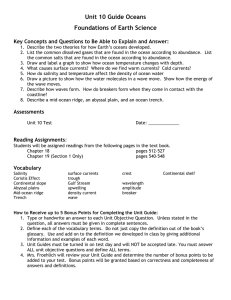Currents and Climate
advertisement

Standards Science 6.4 d Students know the sun is the major source of energy for Earth’s surface. Science 6.4 e Students know differences in pressure, heat, air movement and humidity results in a change in weather. Reading Comprehension -2.5 Comprehension & Analysis of Grade Level Appropriate Text -Clarify and understanding of texts by creating outlines, logical notes, summaries, or reports. Language of the Discipline El Nino La Nina Salinity Upwelling Anticipatory Set Once upon a time, a family was strolling along a beach in Washington and noticed sneakers covered the beach. They had been washed up to shore. A few weeks later the same sneakers showed up in Oregon. After that they showed up in Hawaii! How is this possible? Input/ Surface Currents Affect water to a depth of several hundreds meters are driven mainly by winds. Currents are a large stream of moving water that flows through the ocean. Suns radiation is the ultimate source of energy that powers global winds and surface currents in the ocean. Continentals blocks and redirect the flow of currents. Coriolis Effects Causes global winds to curve as a results of Earth’s rotation It causes surface currents to curve to the right in the Northern hemisphere and to curve to the left in the Southern hemisphere Effects on Climate Surface current warms or cools the air above it, influencing the climate of the land near the coast. Winds pick up moisture as they blow across warm water currents. Cold water currents cool the air above them. Cold air holds less moisture and brings cool, dry weather to the land. El Nino and La Nina El Nino and La Nina are short term changes in the tropical Pacific Ocean caused by changes in ocean surface currents and prevailing winds. Warm water event: El Nino begins with unusally wind patters. It causes the ocean to become warm. Occurs every 2 to 7 years. Brings heavy rains, flooding, and mudslides to California El Nino and La Nina La Nina when surface waters are colder than normal. Brings colder than normal winters and greater precipitation to the Pacific. La Nina causes greater hurricane activity. Deep Currents Deep currents are caused by differences in the density of ocean water. Depends on temperature and salinity The sinking of dense, cold water with high salinity occurs in deep currents formed in the oceans near the poles. Global Conveyer Belt Deep currents move and mix water around the world. They carry cold water from the poles toward the equator. Deep currents flow slowly. Moves water from the tropics towards the poles and cold water to the equator. Dense water sinks near the poles it spreads out and mixes with surrounding water. Upwelling Upwelling brings up tiny ocean organisms, minerals, and other nutrients from the deeper layers of the water. Occurs in the Pacific Ocean. The movement of cold, deep ocean water to replace warm water at the surface. March- September El Nino prevents upwelling from occurring Modeling Identify 5 key components that are important to Currents and climates. 1. Surface currents are driven mainly by winds 2. Surface currents warms or cools the air around it 3. California Current and Davidson Current are two important currents. 4. Continents block and redirect the flow of currents 5. Coriolis changes global winds Checking for Understanding Identify 5 key components that are important to El Nino and La Nina Guided Practice Independent Practice Guided Practice – Worksheet #1-5 Stop! Raise your hand and have your answers checked. Independent Practice – Worksheet # 6-10







